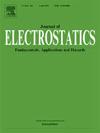The influence of barrier discharge by microplasma drug delivery system probe on cell viability and intracellular drug absorption
IF 1.9
4区 工程技术
Q3 ENGINEERING, ELECTRICAL & ELECTRONIC
引用次数: 0
Abstract
One of plasma medicines greatest accomplishments is the non-invasive drug delivery to cells, tissue, and small animals. Little to no reports has been recorded for intranasal drug delivery with air microplasma at atmospheric condition. This study presents a new design of dielectric barrier discharge microplasma referred to microplasma drug delivery system (DDS) probe for delivery of high molecular weight into DBC1.2 cell line. It is designed by winding a thin wire electrode (ground) around another thin wire electrode (high voltage) coated with a dielectric material. At room condition, the discharge characteristics of this reactor is investigated by activating the peak-to-peak voltage sine waveform. The frequent discharge current affects the dominance of the plasma discharge. The discharge power when the probe is activated at 2 kV, 3 kV, 4 kV, is evaluated, along with its impact on pH of the culture medium, ozone concentration and hydroxyl radicals generated in the medium. Furthermore, the impact of the discharge on cellular processes like growth and viability is accessed alone and during the delivery of FD-70 and FD-150 (MW:70 kDa and 150 kDa) through the intracellular membrane of the cell line. A high delivery of drug was observed in 3 kV and 4 kV discharge voltage. The highest delivery was recorded in 4 kV while 2 kV had similar drug uptake as control. The result of cell growth and viability suggests that the discharge does not show negative impact but rather within the concentration that regulate cellular processes leading to drug permeation and cell growth.
微血浆给药系统探针屏障放电对细胞活力和细胞内药物吸收的影响
血浆药物最大的成就之一是非侵入性地将药物输送到细胞、组织和小动物中。在大气条件下用空气微等离子体经鼻给药的报道很少或没有记录。本研究提出了一种新型介质阻挡放电微等离子体,即微等离子体给药系统(DDS)探针,用于向DBC1.2细胞系递送高分子量药物。它是通过将细线电极(接地)缠绕在另一个涂有介电材料的细线电极(高压)上而设计的。在室内条件下,通过激活峰对峰电压正弦波形来研究该反应器的放电特性。频繁的放电电流影响了等离子体放电的优势。评估探针在2kv、3kv、4kv激活时的放电功率,以及其对培养基pH、臭氧浓度和培养基中产生的羟基自由基的影响。此外,放电对细胞生长和活力等细胞过程的影响是单独的,并且在通过细胞系细胞膜输送FD-70和FD-150 (MW:70 kDa和150 kDa)期间进行的。在3kv和4kv放电电压下,药物的释放量较大。4kv的给药量最高,2kv的给药量与对照相似。细胞生长和活力的结果表明,放电不会产生负面影响,而是在调节细胞过程导致药物渗透和细胞生长的浓度范围内。
本文章由计算机程序翻译,如有差异,请以英文原文为准。
求助全文
约1分钟内获得全文
求助全文
来源期刊

Journal of Electrostatics
工程技术-工程:电子与电气
CiteScore
4.00
自引率
11.10%
发文量
81
审稿时长
49 days
期刊介绍:
The Journal of Electrostatics is the leading forum for publishing research findings that advance knowledge in the field of electrostatics. We invite submissions in the following areas:
Electrostatic charge separation processes.
Electrostatic manipulation of particles, droplets, and biological cells.
Electrostatically driven or controlled fluid flow.
Electrostatics in the gas phase.
 求助内容:
求助内容: 应助结果提醒方式:
应助结果提醒方式:


